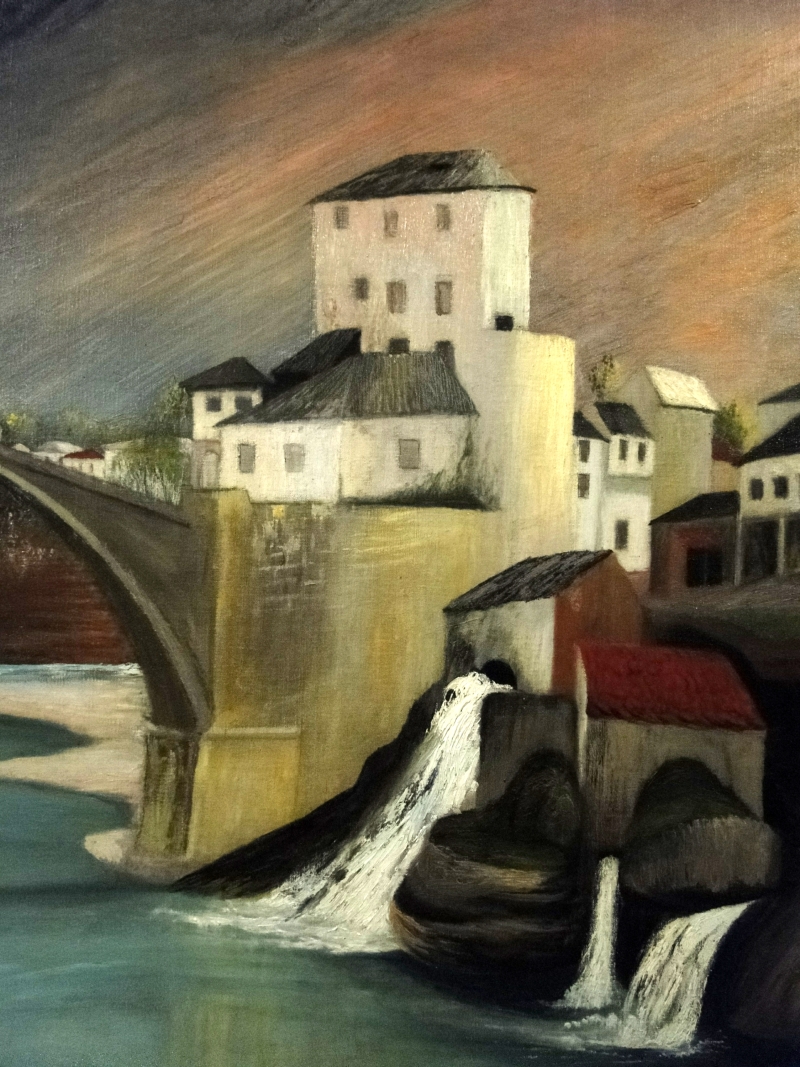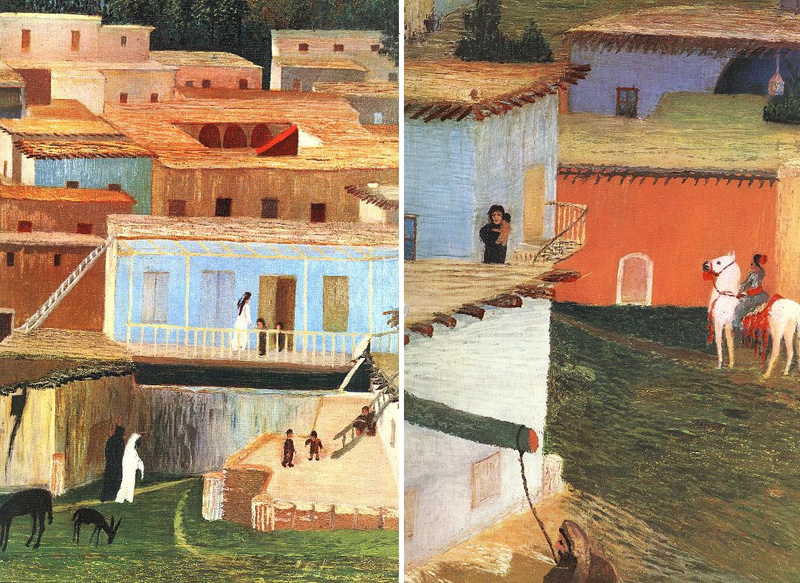Mientras preparaba el post sobre Zsuzsa Máthé, descubrí a este interesante pintor húngaro cuyo estilo para los paisajes me ha gustado mucho.
While preparing the post about Zsuzsa Máthé, I discovered this interesting Hungarian painter whose style to paint landscapes I really liked.
Tivadar Kosztka Csontváry
"Autorretrato / Self-portrait", óleo sobre lienzo / oil on canvas, 39,5 × 67 cm., c.1900.
Galería Nacional de Hungría (Budapest, Hungary)
Tivadar Kosztka Csontváry (Kisszeben, 5 de julio de 1853 - Budapest, 20 de junio de 1919) fue un pintor húngaro adscrito al expresionismo.
Farmacéutico de profesión, a los 27 años se inició en la pintura tras una visión mística que le reveló que sería un gran pintor.
En la cálida y soleada tarde del 13 de octubre de 1880, cuando tenía 27 años, escuchó una voz que le decía. "Serás el más grande de los pintores del «camino del sol» (sunway), ¡más grande que Rafael!".
"El cedro solitario / The Solitary Cedar", óleo sobre lienzo / oil on canvas, 194 x 248 cm., 1907.
Janus Pannonius Museum, (Pécs, Hungría / Hungary)
"Puente romano de Mostar / Roman Bridge at Mostar", óleo sobre lienzo / oil on canvas, 92 x 185 cm., 1903.
Janus Pannonius Museum, (Pécs, Hungría / Hungary)
Desde 1890 realizó un largo viaje por el Mediterráneo (Dalmacia, Italia y Grecia), el norte de África y el Oriente Medio (Líbano, Palestina, Egipto y Siria).
Sus obras principales las pintó entre 1903 y 1909. Realizó algunas exposiciones en París (1907) y Europa Occidental. La mayoría de los críticos europeos reconocieron sus habilidades, arte y genialidad, pero en el Reino de Hungría, durante su vida, fue considerado un maniático excéntrico por varios motivos, por ejemplo por su vegetarianismo, anti-aloholismo, anti-tabaquismo, pacifismo, una latente pero cada vez más perturbadora esquizofrenia, y sus turbios y proféticos escritos y panfletos sobre su vida (Curriculum), genio (La Autoridad, El Genio) y filosofía religiosa (el Positivismo).
"Puente romano de Mostar / Roman Bridge at Mostar" (detalle / detail)
"Calle en Atenas / Street at Athens", óleo sobre lienzo / oil on canvas, 102 x 90 cm., 1904.
Galería Nacional de Hungría (Budapest, Hungary)
"Ciervo / Deer", óleo sobre lienzo / oil on canvas, 100 x 120 cm., 1893. Colección privada / Private Collection
Aunque más tarde fue aclamado, en vida fue muy poco comprendido por su estilo visionario y expresionista. Un solitario por naturaleza, sus "fallos" dañaron su poder creativo.
Su arte conectó con el postimpresionismo y el expresionismo, aunque fue un autodidacta y su estilo es difícilmente clasificable. Aun así ha pasado a la Historia como uno de los más importantes pintores húngaros.
"Otto Heinrl", 1894. Janus Pannonius Museum, Pécs (Hungría / Hungary)
"Primavera en Mostar / Springtime in Mostar", óleo sobre lienzo / oil on canvas, 91 x 69 cm., 1903.
Janus Pannonius Museum, Pécs (Hungría / Hungary)
La información está tomada de Wiki (en español y en inglés) y de su ficha en el sitio web de "Fine Arts in Hungary", donde pueden verse más obras.
"Baalbek", óleo sobre lienzo / oil on canvas, 385 x 714,5 cm., 1906.
Janus Pannonius Museum, Pécs (Hungría / Hungary)
"Baalbek" (detalles / details)
Tivadar Kosztka Csontvárywas was a Hungarian painter who was part of the avant-garde movement of the early twentieth century. Working mostly in Budapest, he was one of the first Hungarian painters to become well known in Europe.
Csontváry was born on 5 July 1853 in Kisszeben, Sáros County, Kingdom of Hungary (today Sabinov, Slovakia), and died 20 June 1919 in Budapest. His ancestors were Poles who settled in Hungary. Although Csontváry was obsessed with his Magyar roots, he grew up speaking Slovak mixed with German. He was a pharmacist until his twenties.
"La Estación Ferroviaria del Este por la noche / The Eastern Railway Station at Night / "
Óleo sobre lienzo / oil on canvas, 44 x 65 cm., 1902. Herman Ottó Museum, (Miskolc, Hungría / Hungary)
"Ruinas del templo de Júpiter en Atenas / Ruins of the Jupiter Temple in Athens"
Óleo sobre lienzo / oil on canvas, 67,5 x 137,5 cm., 1904. Janus Pannonius Museum, Pécs (Hungría / Hungary)
On the hot sunny afternoon of 13 October 1880, when he was 27 years old, he had a mystic vision. He heard a voice saying, "You will be the greatest sunway painter, greater than Raphael!" He took journeys around Europe, visited the galleries of the Vatican, and returned to Hungary to earn money for his journeys by working as an apothecary. From 1890, he traveled around the world. He visited Paris, the Mediterraneum (Dalmatia, Italy, Greece), North Africa and the Middle East (Lebanon, Palestine, Egypt, Syria) and painted pictures.
"Hombre barbudo / Bearded Man", 1894. Janus Pannonius Museum, Pécs (Hungría / Hungary)
"El Monte de los Olivos en Jerusalén / The Mount of Olives in Jerusalem"
Óleo sobre lienzo / oil on canvas, 118 x 115 cm., 1905. Janus Pannonius Museum, Pécs (Hungría / Hungary)
"El Monte de los Olivos en Jerusalén" (detalle / detail)
He painted his major works between 1903 and 1909. He had some exhibitions in Paris (1907) and Western Europe. Most of the critics in Western Europe recognized his abilities, art and congeniality, but in the Kingdom of Hungary during his life, he was considered to be an eccentric crank for several reasons, e. g. for his vegetarianism, anti-alcoholism, anti-smoking, pacifism, a latent, but increasingly disruptive schizophrenia, and his cloudy, prophetic writings and pamphlets about his life (Curriculum), genius (The Authority, The Genius) and religious philosophy (The Positivum). Although he was later acclaimed, during his lifetime Csontváry found little understanding for his visionary, expressionistic style. A loner by nature, his “failure” impaired his creative power.
"La Fuente de María en Nazareth / Mary's Well at Nazareth"
Óleo sobre lienzo / oil on canvas, 362 x 515 cm., 1908. Janus Pannonius Museum, Pécs (Hungría / Hungary)
"La Fuente de María en Nazareth" (detalle / detail)
He painted more than one hundred pictures, the most famous and emblematic of which is probably Magányos cédrus (The Lonely Cedar). His art connects with post-impressionism and expressionism, but he was an autodidact and cannot be classified into one style. He identified as a "sunway"-painter, a term which he created.
"Pueblo a orillas del mar / Town at the Seashore", óleo sobre lienzo / oil on canvas, c. 1902.
Galería Nacional de Hungría (Budapest, Hungary)
"Azor con un lagópodo / Goshawk With a Willow Grouse", óleo sobre lienzo / oil on canvas, 1893
Pannonius Museum, Pécs (Hungría / Hungary)
"Hans", 1894. Pannonius Museum, Pécs (Hungría / Hungary)
Information from Wiki and from his record in the Fine Arts in Hungary's website where you can also enjoy more artworks.
"Fortaleza con árabes montando camellos / Fortress with Arabs Riding Camels"
Óleo sobre lienzo / oil on canvas, 87,5 x 140 cm. Colección privada / Private Collection






















No hay comentarios:
Publicar un comentario